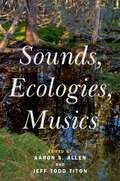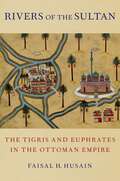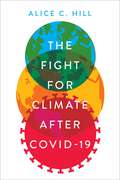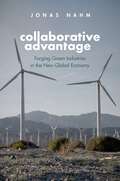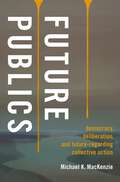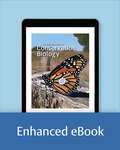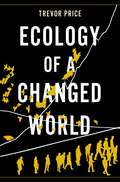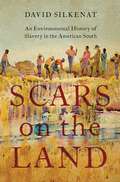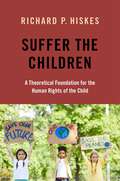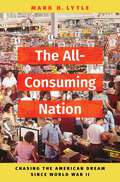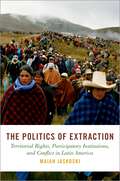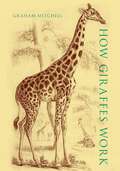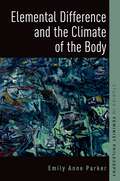- Table View
- List View
Sounds, Ecologies, Musics
by Aaron S. Allen and Jeff Todd TitonSounds, Ecologies, Musics poses exciting challenges and provides fresh opportunities for scholars, scientists, environmental activists, musicians, and listeners to consider music and sound from ecological standpoints. Authors in Part I examine the natural and built environment and how music and sound are woven into it, how the environment enables music and sound, and how the natural and cultural production of music and sound in turn impact the environment. In Part II, contributors consider music and sound in relation to ecological knowledges that appear to conflict with, yet may be viewed as complementary to, Western science: traditional and Indigenous ecological and environmental knowledges. Part III features multidisciplinary and interdisciplinary approaches by scholars, scientists, and practitioners who probe the ecological imaginary regarding the complex ideas and contested keywords that characterize ecomusicology: sound, music, culture, society, environment, and nature. A common theme across the book is the idea of diverse ecologies. Once confined to the natural sciences, the word "ecology" is common today in the social sciences, humanities, and arts - yet its diverse uses have become imprecise and confusing. Engaging the conflicting and complementary meanings of "ecology" requires embracing a both/and approach. Diverse ecologies are illustrated in the methodological, terminological, and topical variety of the chapters as well as the contributors' choice of sources and their disciplinary backgrounds. In times of mounting human and planetary crises, Sounds, Ecologies, Musics challenges disciplinarity and broadens the interdisciplinary field of ecomusicologies. These theoretical and practical studies expand sonic, scholarly, and political activism from the diversity-equity-inclusion agenda of social justice to embrace the more diverse and inclusive agenda of ecocentric ecojustice.
Rivers of the Sultan: The Tigris and Euphrates in the Ottoman Empire
by Faisal H. HusainThe Tigris and Euphrates rivers run through the heart of the Middle East and merge in the area of Mesopotamia known as the "cradle of civilization." In their long and volatile political history, the sixteenth century ushered in a rare era of stability and integration. A series of military campaigns between the Mediterranean Sea and the Persian Gulf brought the entirety of their flow under the institutional control of the Ottoman Empire, then at the peak of its power and wealth. Rivers of the Sultan tells the history of the Tigris and Euphrates during the early modern period. Under the leadership of Sultan Süleyman I, the rivers became Ottoman from mountain to ocean, managed by a political elite that pledged allegiance to a single household, professed a common religion, spoke a lingua franca, and received orders from a central administration based in Istanbul. Faisal Husain details how Ottoman unification institutionalized cooperation among the rivers' dominant users and improved the exploitation of their waters for navigation and food production. Istanbul harnessed the energy and resources of the rivers for its security and economic needs through a complex network of forts, canals, bridges, and shipyards. Above all, the imperial approach to river management rebalanced the natural resource disparity within the Tigris-Euphrates basin. Istanbul regularly organized shipments of grain, metal, and timber from upstream areas of surplus in Anatolia to downstream areas of need in Iraq. Through this policy of natural resource redistribution, the Ottoman Empire strengthened its presence in the eastern borderland region with the Safavid Empire and fended off challenges to its authority. Placing these world historic bodies of water at its center, Rivers of the Sultan reveals intimate bonds between state and society, metropole and periphery, and nature and culture in the early modern world.
Rivers of the Sultan: The Tigris and Euphrates in the Ottoman Empire
by Faisal H. HusainThe Tigris and Euphrates rivers run through the heart of the Middle East and merge in the area of Mesopotamia known as the "cradle of civilization." In their long and volatile political history, the sixteenth century ushered in a rare era of stability and integration. A series of military campaigns between the Mediterranean Sea and the Persian Gulf brought the entirety of their flow under the institutional control of the Ottoman Empire, then at the peak of its power and wealth. Rivers of the Sultan tells the history of the Tigris and Euphrates during the early modern period. Under the leadership of Sultan Süleyman I, the rivers became Ottoman from mountain to ocean, managed by a political elite that pledged allegiance to a single household, professed a common religion, spoke a lingua franca, and received orders from a central administration based in Istanbul. Faisal Husain details how Ottoman unification institutionalized cooperation among the rivers' dominant users and improved the exploitation of their waters for navigation and food production. Istanbul harnessed the energy and resources of the rivers for its security and economic needs through a complex network of forts, canals, bridges, and shipyards. Above all, the imperial approach to river management rebalanced the natural resource disparity within the Tigris-Euphrates basin. Istanbul regularly organized shipments of grain, metal, and timber from upstream areas of surplus in Anatolia to downstream areas of need in Iraq. Through this policy of natural resource redistribution, the Ottoman Empire strengthened its presence in the eastern borderland region with the Safavid Empire and fended off challenges to its authority. Placing these world historic bodies of water at its center, Rivers of the Sultan reveals intimate bonds between state and society, metropole and periphery, and nature and culture in the early modern world.
The Fight for Climate after COVID-19
by Alice C. HillCOVID-19 exposed the world's failure to prepare for the worst -- can we learn to build back better? The COVID-19 pandemic has hit our world on a scale beyond living memory, taking millions of lives and leading to a lockdown of communities worldwide. A pandemic, much like climate change, acts as a threat multiplier, increasing vulnerability to harm, economic impoverishment, and the breakdown of social systems. Even more concerning, communities severely impacted by the coronavirus still remain vulnerable to other types of hazards, such as those brought by accelerating climate change. The catastrophic risks of pandemics and climate change carry deep uncertainty as to when they will occur, how they will unfold, and how much damage they will do. The most important question is how we can face these risks to minimize them most. The Fight for Climate after COVID-19 draws on the troubled and uneven COVID-19 experience to illustrate the critical need to ramp up resilience rapidly and effectively on a global scale. After years of working alongside public health and resilience experts crafting policy to build both pandemic and climate change preparedness, Alice C. Hill exposes parallels between the underutilized measures that governments should have taken to contain the spread of COVID-19 -- such as early action, cross-border planning, and bolstering emergency preparation -- and the steps leaders can take now to mitigate the impacts of climate change. Through practical analyses of current policy and thoughtful guidance for successful climate adaptation, The Fight for Climate after COVID-19 reveals that, just as our society has transformed itself to meet the challenge of coronavirus, so too will we need to adapt our thinking and our policies to combat the ever-increasing threat of climate change. Unapologetic and clear-eyed, The Fight for Climate after COVID-19 helps us understand why the time has come to prepare for the world as it will be, rather than as it once was.
The Fight for Climate after COVID-19
by Alice C. HillCOVID-19 exposed the world's failure to prepare for the worst -- can we learn to build back better? The COVID-19 pandemic has hit our world on a scale beyond living memory, taking millions of lives and leading to a lockdown of communities worldwide. A pandemic, much like climate change, acts as a threat multiplier, increasing vulnerability to harm, economic impoverishment, and the breakdown of social systems. Even more concerning, communities severely impacted by the coronavirus still remain vulnerable to other types of hazards, such as those brought by accelerating climate change. The catastrophic risks of pandemics and climate change carry deep uncertainty as to when they will occur, how they will unfold, and how much damage they will do. The most important question is how we can face these risks to minimize them most. The Fight for Climate after COVID-19 draws on the troubled and uneven COVID-19 experience to illustrate the critical need to ramp up resilience rapidly and effectively on a global scale. After years of working alongside public health and resilience experts crafting policy to build both pandemic and climate change preparedness, Alice C. Hill exposes parallels between the underutilized measures that governments should have taken to contain the spread of COVID-19 -- such as early action, cross-border planning, and bolstering emergency preparation -- and the steps leaders can take now to mitigate the impacts of climate change. Through practical analyses of current policy and thoughtful guidance for successful climate adaptation, The Fight for Climate after COVID-19 reveals that, just as our society has transformed itself to meet the challenge of coronavirus, so too will we need to adapt our thinking and our policies to combat the ever-increasing threat of climate change. Unapologetic and clear-eyed, The Fight for Climate after COVID-19 helps us understand why the time has come to prepare for the world as it will be, rather than as it once was.
Collaborative Advantage: Forging Green Industries in the New Global Economy
by Jonas NahmCollaborative Advantage offers a bold new take on the drivers and consequences of globalization, both for innovation in renewable energy industries and domestic politics. In an era of rapid international economic integration, how do countries interact, innovate, and compete in industries, like energy, that are fundamental to national interests? In Collaborative Advantage, Jonas Nahm examines the development of the wind and solar industries, two historically important sectors that have long been the target of ambitious public policy. As wind and solar grew from cottage industries into lucrative global sectors of geopolitical importance, China, Germany, and the United States each developed distinct constellations of firms with starkly different technical capabilities. The book shows that globalization itself has reinforced such distinct national patterns of industrial specialization. Economically, globalization has allowed domestic firms to specialize in specific activities because of new opportunities to collaborate with firms from abroad. Politically, new possibilities for specialization have allowed firms to repurpose existing domestic institutions for application in new industries. Against the backdrop of policy efforts that have generally failed to grasp the cross-national nature of innovation, the book offers a novel explanation for both the causes of changes in the global organization of innovation and their impact on domestic politics. As interdependence in global supply chains has again come under fire in the wake of the Covid-19 pandemic, Collaborative Advantage challenges the notion that globalization is primarily about competition between nations, highlighting instead the central role of international collaboration in the global economy, particularly in clean energy industries critical to solving the climate crisis.
Collaborative Advantage: Forging Green Industries in the New Global Economy
by Jonas NahmCollaborative Advantage offers a bold new take on the drivers and consequences of globalization, both for innovation in renewable energy industries and domestic politics. In an era of rapid international economic integration, how do countries interact, innovate, and compete in industries, like energy, that are fundamental to national interests? In Collaborative Advantage, Jonas Nahm examines the development of the wind and solar industries, two historically important sectors that have long been the target of ambitious public policy. As wind and solar grew from cottage industries into lucrative global sectors of geopolitical importance, China, Germany, and the United States each developed distinct constellations of firms with starkly different technical capabilities. The book shows that globalization itself has reinforced such distinct national patterns of industrial specialization. Economically, globalization has allowed domestic firms to specialize in specific activities because of new opportunities to collaborate with firms from abroad. Politically, new possibilities for specialization have allowed firms to repurpose existing domestic institutions for application in new industries. Against the backdrop of policy efforts that have generally failed to grasp the cross-national nature of innovation, the book offers a novel explanation for both the causes of changes in the global organization of innovation and their impact on domestic politics. As interdependence in global supply chains has again come under fire in the wake of the Covid-19 pandemic, Collaborative Advantage challenges the notion that globalization is primarily about competition between nations, highlighting instead the central role of international collaboration in the global economy, particularly in clean energy industries critical to solving the climate crisis.
Future Publics: Democracy, Deliberation, and Future-Regarding Collective Action
by Michael K. MacKenzieScholars have often claimed that democracies, whatever their virtues, are functionally short-sighted. The evidence is clear: we have been unable to manage many long-term issues including climate change, nuclear waste disposal, natural disaster preparedness, infrastructure maintenance, and budget deficits. If voters and influential actors, such as interest groups and corporations, have dominant short-term interests, it may be difficult for elected politicians to act in the long-term interests of society, even if they think that it would be the right thing to do. To solve long-term problems, do we need political systems that are less democratic, or even authoritarian? This idea, which Michael K. MacKenzie calls the "democratic myopia thesis," is a sort of conventional wisdom; it is an idea that scholars and pundits take for granted as a truth about democracy without subjecting it to adequate critical scrutiny. In Future Publics, MacKenzie challenges this conventional wisdom and articulates a deliberative, democratic theory of future-regarding collective action. Specifically, MacKenzie argues that each part of the democratic myopia problem can be addressed through democratic--rather than authoritarian--means. At a more fundamental level, once we recognize that democratic practices are world-making activities that empower us to make our shared worlds together, they should also be understood as future-making activities. Despite the short-term dynamics associated with electoral democracy, MacKenzie asserts that we need more inclusive and deliberative democracies if we are going to make shared futures that will work for us all.
Future Publics: Democracy, Deliberation, and Future-Regarding Collective Action
by Michael K. MacKenzieScholars have often claimed that democracies, whatever their virtues, are functionally short-sighted. The evidence is clear: we have been unable to manage many long-term issues including climate change, nuclear waste disposal, natural disaster preparedness, infrastructure maintenance, and budget deficits. If voters and influential actors, such as interest groups and corporations, have dominant short-term interests, it may be difficult for elected politicians to act in the long-term interests of society, even if they think that it would be the right thing to do. To solve long-term problems, do we need political systems that are less democratic, or even authoritarian? This idea, which Michael K. MacKenzie calls the "democratic myopia thesis," is a sort of conventional wisdom; it is an idea that scholars and pundits take for granted as a truth about democracy without subjecting it to adequate critical scrutiny. In Future Publics, MacKenzie challenges this conventional wisdom and articulates a deliberative, democratic theory of future-regarding collective action. Specifically, MacKenzie argues that each part of the democratic myopia problem can be addressed through democratic--rather than authoritarian--means. At a more fundamental level, once we recognize that democratic practices are world-making activities that empower us to make our shared worlds together, they should also be understood as future-making activities. Despite the short-term dynamics associated with electoral democracy, MacKenzie asserts that we need more inclusive and deliberative democracies if we are going to make shared futures that will work for us all.
An Introduction to Conservation Biology
by Anna SherAn Introduction to Conservation Biology is the only text designed for both aspiring conservation biologists and non-majors who are interested in this topical field, providing up-to-date perspectives on high-profile issues such as sustainable development, global warming, and strategies to save species on the verge of extinction. The book focuses successively on biological diversity and its value; threats to biological diversity; conservation at the population and species levels; protecting, managing and restoring ecosystems; and sustainable development. Each chapter is beautifully illustrated in full color with diverse examples from the current literature. Chapters begin with guiding conservation biology principles and end with study aids such as summaries, an annotated list of suggested readings, and discussion questions. Throughout, the authors maintain a focus on the active role that scientists, local people, conservation organizations, government, and the general public play in protecting biodiversity, even while providing for human needs.
Ecology of a Changed World
by Trevor PriceAn increasing amount of usable space on our planet is crowded by humans. Whether we are using the space for permanent homes, vacation homes, travel accommodations, farming, public recreation, transportation, or office buildings, our chronic overuse of Earth's resources is pushing our ecosystem into uncharted territories. This has spurred many species extinctions, and we can expect the losses to continue to grow. Ecology of a Changed World outlines the importance of species conservation relative to human existence. The book breaks down ecological principles and explains six threats to biodiversity in terms anyone studying ecology, evolutionary biology, environmental science, or environmental justice will understand. Ecologist Trevor Price begins the book by breaking down population growth, food webs, species interaction, and other ecological principles. He draws on examples from agriculture, disease, fisheries, and societal growth throughout each chapter, offering insight into the relationships between demographic transitions, monetary exchanges, and ecosystems. Price focuses on six threats to biodiversity--climate change, overharvesting, pollution, habitat loss, invasive species, and disease--and offers the history, current status, and economic as well as environmental impacts of each of these. He ends the book with a rigorous review of the importance of species diversity, outlining the ways losses to our ecosystem will be a detriment to public health and global wealth. Taking readers through competition, predation, and parasitism, Ecology of a Changed World helpfully traces what has occurred on our planet throughout history, why these things happened, and how we can use this information to determine and shape our future.
Ecology of a Changed World
by Trevor PriceAn increasing amount of usable space on our planet is crowded by humans. Whether we are using the space for permanent homes, vacation homes, travel accommodations, farming, public recreation, transportation, or office buildings, our chronic overuse of Earth's resources is pushing our ecosystem into uncharted territories. This has spurred many species extinctions, and we can expect the losses to continue to grow. Ecology of a Changed World outlines the importance of species conservation relative to human existence. The book breaks down ecological principles and explains six threats to biodiversity in terms anyone studying ecology, evolutionary biology, environmental science, or environmental justice will understand. Ecologist Trevor Price begins the book by breaking down population growth, food webs, species interaction, and other ecological principles. He draws on examples from agriculture, disease, fisheries, and societal growth throughout each chapter, offering insight into the relationships between demographic transitions, monetary exchanges, and ecosystems. Price focuses on six threats to biodiversity--climate change, overharvesting, pollution, habitat loss, invasive species, and disease--and offers the history, current status, and economic as well as environmental impacts of each of these. He ends the book with a rigorous review of the importance of species diversity, outlining the ways losses to our ecosystem will be a detriment to public health and global wealth. Taking readers through competition, predation, and parasitism, Ecology of a Changed World helpfully traces what has occurred on our planet throughout history, why these things happened, and how we can use this information to determine and shape our future.
Scars on the Land: An Environmental History of Slavery in the American South
by David SilkenatThey worked Virginia's tobacco fields, South Carolina's rice marshes, and the Black Belt's cotton plantations. Wherever they lived, enslaved people found their lives indelibly shaped by the Southern environment. By day, they plucked worms and insects from the crops, trod barefoot in the mud as they hoed rice fields, and endured the sun and humidity as they planted and harvested the fields. By night, they clandestinely took to the woods and swamps to trap opossums and turtles, to visit relatives living on adjacent plantations, and at times to escape slave patrols and escape to freedom. Scars on the Land is the first comprehensive history of American slavery to examine how the environment fundamentally formed enslaved people's lives and how slavery remade the Southern landscape. Over two centuries, from the establishment of slavery in the Chesapeake to the Civil War, one simple calculation had profound consequences: rather than measuring productivity based on outputs per acre, Southern planters sought to maximize how much labor they could extract from their enslaved workforce. They saw the landscape as disposable, relocating to more fertile prospects once they had leached the soils and cut down the forests. On the leading edge of the frontier, slavery laid waste to fragile ecosystems, draining swamps, clearing forests to plant crops and fuel steamships, and introducing devastating invasive species. On its trailing edge, slavery left eroded hillsides, rivers clogged with sterile soil, and the extinction of native species. While environmental destruction fueled slavery's expansion, no environment could long survive intensive slave labor. The scars manifested themselves in different ways, but the land too fell victim to the slave owner's lash. Although typically treated separately, slavery and the environment naturally intersect in complex and powerful ways, leaving lasting effects from the period of emancipation through modern-day reckonings with racial justice.
Scars on the Land: An Environmental History of Slavery in the American South
by David SilkenatThey worked Virginia's tobacco fields, South Carolina's rice marshes, and the Black Belt's cotton plantations. Wherever they lived, enslaved people found their lives indelibly shaped by the Southern environment. By day, they plucked worms and insects from the crops, trod barefoot in the mud as they hoed rice fields, and endured the sun and humidity as they planted and harvested the fields. By night, they clandestinely took to the woods and swamps to trap opossums and turtles, to visit relatives living on adjacent plantations, and at times to escape slave patrols and escape to freedom. Scars on the Land is the first comprehensive history of American slavery to examine how the environment fundamentally formed enslaved people's lives and how slavery remade the Southern landscape. Over two centuries, from the establishment of slavery in the Chesapeake to the Civil War, one simple calculation had profound consequences: rather than measuring productivity based on outputs per acre, Southern planters sought to maximize how much labor they could extract from their enslaved workforce. They saw the landscape as disposable, relocating to more fertile prospects once they had leached the soils and cut down the forests. On the leading edge of the frontier, slavery laid waste to fragile ecosystems, draining swamps, clearing forests to plant crops and fuel steamships, and introducing devastating invasive species. On its trailing edge, slavery left eroded hillsides, rivers clogged with sterile soil, and the extinction of native species. While environmental destruction fueled slavery's expansion, no environment could long survive intensive slave labor. The scars manifested themselves in different ways, but the land too fell victim to the slave owner's lash. Although typically treated separately, slavery and the environment naturally intersect in complex and powerful ways, leaving lasting effects from the period of emancipation through modern-day reckonings with racial justice.
An Introduction to Conservation Biology
by Anna SherAn Introduction to Conservation Biology is the only text designed for both aspiring conservation biologists and non-majors who are interested in this topical field, providing up-to-date perspectives on high-profile issues such as sustainable development, global warming, and strategies to save species on the verge of extinction. The book focuses successively on biological diversity and its value; threats to biological diversity; conservation at the population and species levels; protecting, managing and restoring ecosystems; and sustainable development. Each chapter is beautifully illustrated in full color with diverse examples from the current literature. Chapters begin with guiding conservation biology principles and end with study aids such as summaries, an annotated list of suggested readings, and discussion questions. Throughout, the authors maintain a focus on the active role that scientists, local people, conservation organizations, government, and the general public play in protecting biodiversity, even while providing for human needs.
Suffer the Children: A Theoretical Foundation for the Human Rights of the Child
by Richard P. HiskesIn 1973, Hillary Rodham Clinton famously stated that "children's rights" is a slogan in search of a definition, used to bolster various arguments for peace and for specific rights, but without any coherent conception of children as political beings. In 1989, the United Nations established the basis for this definition in the Convention on the Rights of the Child (CRC), a document every nation in the world, save the United States, has ratified. Still, human rights theorists, scholars, and jurists continue to disagree as to the theoretical justification for children's human rights. In Suffer the Children, Richard P. Hiskes establishes the first substantive theoretical foundation for the human rights of children. As Hiskes argues, recognizing the rights of children fundamentally alters the meaning and usefulness of human rights in a global context. Ironically, the case for children's rights, as Hiskes argues, should be seen as the evolution, distillation, or "maturing" of human rights in general. Children's human rights will end the debate about whether groups can have rights because, globally, many rights claims today are precisely group claims, including those from children. Moreover, Hiskes provides a new critical assessment of the United Nations CRC and explores child activism for human rights worldwide--in courts, on social networks, and in public demonstrations--to show how children are already claiming their rights in ways that will fundamentally change the meaning both of rights themselves and of democratic processes. Giving children rights in a way that avoids privileging any single cultural experience of children would make rights no longer a "Western," individualistic idea, but a truly global one.
Suffer the Children: A Theoretical Foundation for the Human Rights of the Child
by Richard P. HiskesIn 1973, Hillary Rodham Clinton famously stated that "children's rights" is a slogan in search of a definition, used to bolster various arguments for peace and for specific rights, but without any coherent conception of children as political beings. In 1989, the United Nations established the basis for this definition in the Convention on the Rights of the Child (CRC), a document every nation in the world, save the United States, has ratified. Still, human rights theorists, scholars, and jurists continue to disagree as to the theoretical justification for children's human rights. In Suffer the Children, Richard P. Hiskes establishes the first substantive theoretical foundation for the human rights of children. As Hiskes argues, recognizing the rights of children fundamentally alters the meaning and usefulness of human rights in a global context. Ironically, the case for children's rights, as Hiskes argues, should be seen as the evolution, distillation, or "maturing" of human rights in general. Children's human rights will end the debate about whether groups can have rights because, globally, many rights claims today are precisely group claims, including those from children. Moreover, Hiskes provides a new critical assessment of the United Nations CRC and explores child activism for human rights worldwide--in courts, on social networks, and in public demonstrations--to show how children are already claiming their rights in ways that will fundamentally change the meaning both of rights themselves and of democratic processes. Giving children rights in a way that avoids privileging any single cultural experience of children would make rights no longer a "Western," individualistic idea, but a truly global one.
The All-Consuming Nation: Chasing the American Dream Since World War II
by Mark H. LytleIn his 1958 "kitchen debate" with Nikita Khrushchev, Richard Nixon argued that the freedom to consume defined the American way of life. High wages, full employment, new technologies, and a rapid growth in population known as the "Baby Boom" ushered in a golden age of economic growth. By the end of the twentieth century, consumerism triumphed over communism, socialism, and all other isms seeking to win hearts and minds around the world. Advertising, popular culture, and mass media persuaded Americans that shopping was both spiritually fulfilling and a patriotic virtue. Mark Lytle argues that Nixon's view of consumer democracy contained fatal flaws -- if unregulated, it would wholly ignore the creativedestruction that, in destroying jobs, erodes the capacity to consume. The All-Consuming Nation also examines how planners failed to take into account the environmental costs, as early warning signs--whether smog over Los Angeles, the overuse of toxic chemicals such as DDT, or the Cuyahoga River in flames--provided evidence that all was not well. Environmentalists from Aldo Leopold, Rachel Carson and Paul Ehrlich to Ralph Nader and Al Gore cautioned that modern consumerism imposed unsustainable costs on the natural world. Not for lack of warning, climate change became the defining issue of the twenty-first century. The All-Consuming Nation investigates the environmental and sociocultural costs of the consumer capitalism framework set in place in the 20th century, shedding light on the consequences of a national identity forged through mass consumption.
The All-Consuming Nation: Chasing the American Dream Since World War II
by Mark H. LytleIn his 1958 "kitchen debate" with Nikita Khrushchev, Richard Nixon argued that the freedom to consume defined the American way of life. High wages, full employment, new technologies, and a rapid growth in population known as the "Baby Boom" ushered in a golden age of economic growth. By the end of the twentieth century, consumerism triumphed over communism, socialism, and all other isms seeking to win hearts and minds around the world. Advertising, popular culture, and mass media persuaded Americans that shopping was both spiritually fulfilling and a patriotic virtue. Mark Lytle argues that Nixon's view of consumer democracy contained fatal flaws -- if unregulated, it would wholly ignore the creativedestruction that, in destroying jobs, erodes the capacity to consume. The All-Consuming Nation also examines how planners failed to take into account the environmental costs, as early warning signs--whether smog over Los Angeles, the overuse of toxic chemicals such as DDT, or the Cuyahoga River in flames--provided evidence that all was not well. Environmentalists from Aldo Leopold, Rachel Carson and Paul Ehrlich to Ralph Nader and Al Gore cautioned that modern consumerism imposed unsustainable costs on the natural world. Not for lack of warning, climate change became the defining issue of the twenty-first century. The All-Consuming Nation investigates the environmental and sociocultural costs of the consumer capitalism framework set in place in the 20th century, shedding light on the consequences of a national identity forged through mass consumption.
The Politics of Extraction: Territorial Rights, Participatory Institutions, and Conflict in Latin America (Studies in Comparative Energy and Environmental Politics)
by Maiah JaskoskiMining and hydrocarbon production in Latin America is high-stakes for extractive firms, communities in resource-rich zones, and states. Amid global commodity price increases and liberal economic policies, the sectors have expanded dramatically in recent decades. This surge has made private investors and governments in the region ever more committed to extraction. It also has increased alarm within local communities, which have organized around the environmental, cultural, and social impacts of mining and hydrocarbons. Moreover, activists have mobilized to demand material benefits, in the forms of royalty distributions and direct company investment in local services and infrastructure. These conflicts take the form of legal battles, large-scale protests, and standoffs that pit communities against companies and the state, and consequently have suspended production, destabilized politics, and expended state security resources. In The Politics of Extraction, Maiah Jaskoski looks at how mobilized communities in Latin America's hydrocarbon and mining regions use participatory institutions to challenge extraction. In some cases, communities act within formal participatory spaces, while in others, they organize "around" or "in reaction to" these institutions, using participatory procedures as focal points in the escalation of conflict. Based on analysis of thirty major extractive conflicts in Bolivia, Colombia, and Peru in the 2000s and 2010s, Jaskoski examines community uses of public hearings built into environmental licensing, state-led prior consultation with native communities affected by large-scale development, and local popular consultations or referenda. She finds that communities select their strategies in response to the specific participatory challenges they confront: the trials of initiating participatory processes, gaining inclusion in participatory events, and, for communities with such access, expressing views about extraction at the participatory stage. Surprisingly, the communities least likely to channel their concerns through state institutions are the most unified and have the strongest guarantee of participation. Including a wealth of data and complex stories, Jaskoski provides the first systematic study of how participatory institutions either channel or exacerbate conflict over extraction.
The Politics of Extraction: Territorial Rights, Participatory Institutions, and Conflict in Latin America (Studies in Comparative Energy and Environmental Politics)
by Maiah JaskoskiMining and hydrocarbon production in Latin America is high-stakes for extractive firms, communities in resource-rich zones, and states. Amid global commodity price increases and liberal economic policies, the sectors have expanded dramatically in recent decades. This surge has made private investors and governments in the region ever more committed to extraction. It also has increased alarm within local communities, which have organized around the environmental, cultural, and social impacts of mining and hydrocarbons. Moreover, activists have mobilized to demand material benefits, in the forms of royalty distributions and direct company investment in local services and infrastructure. These conflicts take the form of legal battles, large-scale protests, and standoffs that pit communities against companies and the state, and consequently have suspended production, destabilized politics, and expended state security resources. In The Politics of Extraction, Maiah Jaskoski looks at how mobilized communities in Latin America's hydrocarbon and mining regions use participatory institutions to challenge extraction. In some cases, communities act within formal participatory spaces, while in others, they organize "around" or "in reaction to" these institutions, using participatory procedures as focal points in the escalation of conflict. Based on analysis of thirty major extractive conflicts in Bolivia, Colombia, and Peru in the 2000s and 2010s, Jaskoski examines community uses of public hearings built into environmental licensing, state-led prior consultation with native communities affected by large-scale development, and local popular consultations or referenda. She finds that communities select their strategies in response to the specific participatory challenges they confront: the trials of initiating participatory processes, gaining inclusion in participatory events, and, for communities with such access, expressing views about extraction at the participatory stage. Surprisingly, the communities least likely to channel their concerns through state institutions are the most unified and have the strongest guarantee of participation. Including a wealth of data and complex stories, Jaskoski provides the first systematic study of how participatory institutions either channel or exacerbate conflict over extraction.
How Giraffes Work
by Graham MitchellThere are few creatures more beautiful, aloof, and fascinating than giraffes. Their social and ecological impact has been documented by many researchers. However, the inner workings of extant giraffes are less well known. That is why Graham Mitchell decided to write How Giraffes Work: a comprehensive overview of the anatomy, physiology, and biochemistry--in short, the normal functions--of a free-living, wild animal in its natural environment. A zoologist, veterinarian, and physiologist, Mitchell explains how giraffes get through their day. Additionally, he takes readers through the evolution of their physical characteristics, such as their size, shape, and coat markings. His approach integrates history with the physiology, anatomy, biochemistry, behavior, evolution, genetics, ecology, climate science, and more. Each chapter follows the discovery and utility of a different characteristic of giraffes. Illustrated with over two hundred figures and diagrams, the book explains how giraffes might have evolved and survived over many millions of years as well as how our perception of them has changed throughout history. So, how do giraffes work? The answers lie in a story filled not only with the details of their internal working but also with the labors of the extraordinary scientists who have put so many pieces of this puzzle together.
How Giraffes Work
by Graham MitchellThere are few creatures more beautiful, aloof, and fascinating than giraffes. Their social and ecological impact has been documented by many researchers. However, the inner workings of extant giraffes are less well known. That is why Graham Mitchell decided to write How Giraffes Work: a comprehensive overview of the anatomy, physiology, and biochemistry--in short, the normal functions--of a free-living, wild animal in its natural environment. A zoologist, veterinarian, and physiologist, Mitchell explains how giraffes get through their day. Additionally, he takes readers through the evolution of their physical characteristics, such as their size, shape, and coat markings. His approach integrates history with the physiology, anatomy, biochemistry, behavior, evolution, genetics, ecology, climate science, and more. Each chapter follows the discovery and utility of a different characteristic of giraffes. Illustrated with over two hundred figures and diagrams, the book explains how giraffes might have evolved and survived over many millions of years as well as how our perception of them has changed throughout history. So, how do giraffes work? The answers lie in a story filled not only with the details of their internal working but also with the labors of the extraordinary scientists who have put so many pieces of this puzzle together.
Elemental Difference and the Climate of the Body (Studies in Feminist Philosophy)
by Emily Anne ParkerIn nineteenth-century Europe, differences among human bodies were understood to be matters of scientific classification. At the height of scientific acceptance, it was unthinkable that race or sex or diagnosis or indigence were invention. Today, however, differences among human bodies are understood as matters of social construction. The philosophy of social construction understands differences among humans to be matters of human imposition. Social constructionism's way of understanding the origin of differences among humans is so well-established as to have no currently viable alternatives, even among new materialists, social constructionism's most ardent critics. This book argues that new materialists and social constructionists share a distinction between the political and the ecological. Emily Anne Parker centers her argument on the philosophical concept of the polis, according to which there is one complete human form. It is this form that is to blame for our current political and ecological crisis. Political hierarchies and ecological crises are often considered to be two different problems: for example, many speak of parallel problems, climate change and racial injustice. Parker argues that these are not parallel crises so much as one problem: the polis. The philosophy of the polis asserts that there is one complete human body, and that body is meant to govern all other things. In that sense there are not two crises, but instead one concern: to perceive the ways in which this tradition of the polis constrains the present. Elemental difference in the polis is appreciated in the fact that "empirical bodily non-identity," an Aristotelian concept, can be called upon to elevate one group of bodies among the rest. Parker builds from Sylvia Wynter, who argues that the very idea of empirical bodily non-identity begins with the modern science of racial anatomy, or what Wynter calls biocentrism. Parker argues that biocentrism is a feature of the polis, according to which the one complete body was defined by its capacity for disembodied thought. The sciences of racial anatomy are a more explicit commitment to biocentrism, but the ranking of matter with respect to one complete human, a body that is the site of supra-natural thinking, is a practice that has always characterized the polis. In this way, the polis is responsible for both political and ecological hierarchy. It is as responsible for what is euphemistically called climate change as it is for the political hierarchy that constitutes it. Elemental Difference and the Climate of the Body ultimately bridges the insights of social constructionism and new materialisms to create a philosophy of elemental difference. Difference, rather than needing to be either dismissed based on its social construction or reified in keeping with the hierarchies of the polis, is crucial for addressing contemporary crises of the polis.
Elemental Difference and the Climate of the Body (Studies in Feminist Philosophy)
by Emily Anne ParkerIn nineteenth-century Europe, differences among human bodies were understood to be matters of scientific classification. At the height of scientific acceptance, it was unthinkable that race or sex or diagnosis or indigence were invention. Today, however, differences among human bodies are understood as matters of social construction. The philosophy of social construction understands differences among humans to be matters of human imposition. Social constructionism's way of understanding the origin of differences among humans is so well-established as to have no currently viable alternatives, even among new materialists, social constructionism's most ardent critics. This book argues that new materialists and social constructionists share a distinction between the political and the ecological. Emily Anne Parker centers her argument on the philosophical concept of the polis, according to which there is one complete human form. It is this form that is to blame for our current political and ecological crisis. Political hierarchies and ecological crises are often considered to be two different problems: for example, many speak of parallel problems, climate change and racial injustice. Parker argues that these are not parallel crises so much as one problem: the polis. The philosophy of the polis asserts that there is one complete human body, and that body is meant to govern all other things. In that sense there are not two crises, but instead one concern: to perceive the ways in which this tradition of the polis constrains the present. Elemental difference in the polis is appreciated in the fact that "empirical bodily non-identity," an Aristotelian concept, can be called upon to elevate one group of bodies among the rest. Parker builds from Sylvia Wynter, who argues that the very idea of empirical bodily non-identity begins with the modern science of racial anatomy, or what Wynter calls biocentrism. Parker argues that biocentrism is a feature of the polis, according to which the one complete body was defined by its capacity for disembodied thought. The sciences of racial anatomy are a more explicit commitment to biocentrism, but the ranking of matter with respect to one complete human, a body that is the site of supra-natural thinking, is a practice that has always characterized the polis. In this way, the polis is responsible for both political and ecological hierarchy. It is as responsible for what is euphemistically called climate change as it is for the political hierarchy that constitutes it. Elemental Difference and the Climate of the Body ultimately bridges the insights of social constructionism and new materialisms to create a philosophy of elemental difference. Difference, rather than needing to be either dismissed based on its social construction or reified in keeping with the hierarchies of the polis, is crucial for addressing contemporary crises of the polis.
